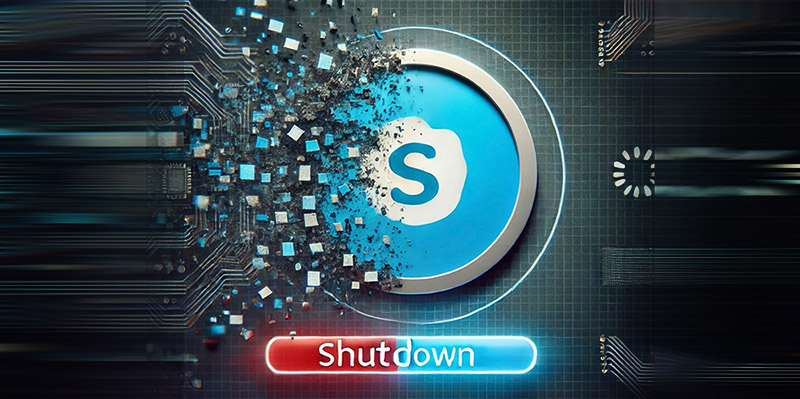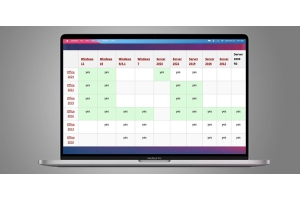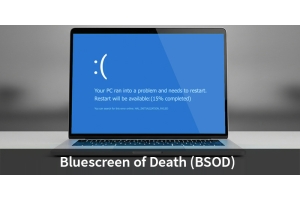Microsoft to End Skype in May 2025: The Reasons Behind It and the Best Alternatives



In the ever-changing world of digital communication, Microsoft has made a significant decision: Skype will be discontinued in May 2025. This marks the end of an era for the popular VoIP service, which revolutionized the way we communicate globally. But what does this decision mean for Skype users? In this article, we take a detailed look at the reasons behind the end of Skype and what this means for users and the entire digital communication landscape.
The History of Skype: A Look Back at the VoIP Pioneer
Skype was founded in 2003 and was one of the first services to allow free voice and video calls worldwide. As a synonym for VoIP (Voice over Internet Protocol), Skype experienced significant growth, especially for international calls, as it was much cheaper than traditional phone lines.
In 2011, Microsoft acquired Skype for $8.5 billion to strengthen its communication platform and become a leading provider in collaboration and communication. However, Skype's success was not to last. With the rise of Zoom, WhatsApp, and Microsoft Teams, Skype gradually lost its relevance.
Microsoft Teams: The New Era of Collaboration
The real turning point came in 2017 with the launch of Microsoft Teams. Teams was designed to be more than just a communication tool. It integrates video conferencing, chat, document editing, and third-party app integrations into a single platform, enabling seamless collaboration for teams and businesses. Teams quickly became the preferred solution for companies worldwide.
The true breakthrough for Teams came during the COVID-19 pandemic when video conferencing and online collaboration became essential. Teams not only offered video conferencing but also deeper integration with Microsoft 365 tools like Word, Excel, and PowerPoint, making it the preferred solution for many businesses.
Why Skype is Being Discontinued: Microsoft’s Decision
In February 2025, Microsoft officially announced that it would discontinue Skype in May 2025. The decision to shut down Skype is part of a broader strategy that focuses on Microsoft Teams. Skype, which had seen less innovation in recent years, was increasingly viewed as outdated and redundant, especially compared to the modern features offered by Microsoft Teams.
There are several key reasons behind the discontinuation of Skype and the focus on Teams:
- Market Development and Competition: The market for communication apps has changed dramatically. Platforms like Zoom, WhatsApp, and Slack offer many features that Skype can no longer match. Teams has surpassed Skype in many ways.
- Focus on Microsoft Teams: Teams offers not only video calls but also full integration of collaboration tools that Skype could not provide. Microsoft has chosen to concentrate its resources on Teams and discontinue the development of Skype.
- Changed User Behavior: Skype was particularly popular for international calls, but internet-based voice and video calls have been taken over by platforms like WhatsApp and FaceTime, which offer users more convenient and modern features.
- Streamlining the Microsoft Ecosystem: Microsoft has established Teams as the central communication platform, fully integrated into Microsoft 365. This makes Skype redundant and gives users a consistent and integrated experience.
What Does This Mean for Skype Users?
Microsoft's decision to discontinue Skype by May 2025 affects millions of users worldwide. For many who have used Skype for video calls, voice communication, and text messaging for years, this represents a significant change. Starting in March 2025, Microsoft will offer users the ability to migrate their Skype data to Microsoft Teams (Free). This includes contacts, chat history, and call logs. The migration process is designed to ensure that existing connections are not lost, allowing users to continue their communication seamlessly. Teams will be designed to take over Skype's core functions—such as contact management and basic chat features.
However, the transition from Skype to Microsoft Teams can be especially challenging for personal users. Teams was initially designed as a business platform and therefore includes many features geared toward team collaboration, projects, and teamwork. These features can feel overwhelming for the average Skype user, particularly if they don't use Teams for work purposes. For personal users, this means they will need to adjust to a new interface that includes many additional tools and settings that Skype didn’t have. This will require some adjustment time and a change in their usual workflows.
Microsoft has announced that they plan to make Teams more user-friendly to make the transition as easy as possible for Skype users. Microsoft will provide an optimized version of Teams, particularly designed for personal use. This version will seamlessly take over Skype's core functions, such as video calls, text messaging, and voice chats, but with a clearer, simpler interface that suits individuals and smaller groups. Additionally, Teams will increasingly become more mobile-friendly, ensuring that Skype users who primarily communicate via smartphones will not experience any limitations.
Another advantage of switching to Teams is that it offers many more features than Skype. Teams provides better integration with Microsoft 365, allowing Office documents like Word, Excel, and PowerPoint to be used directly in chats and calls. Those who already use Microsoft products will benefit from this deep integration. For users who have previously relied on Skype for basic communication, this means they can discover new possibilities for their communication.
Nonetheless, the transition will be an adjustment for many, especially those who have heavily relied on Skype for personal use. Microsoft recommends making the switch early to get accustomed to the new features and complete the data migration in time. In the coming months before the final shutdown, Microsoft will continue to provide resources, including training, support articles, and tutorials, to help users prepare for using Teams and understand how to use their familiar functions on the new platform.
Alternatives to Skype and Teams: Which Services Can Be Used?
Although Skype will be discontinued after over two decades, there are numerous alternatives that offer similar features and, in some cases, even more possibilities for communication and collaboration. The choice of the best service depends on individual needs, whether for personal conversations, video conferences, or team collaboration. Here are some of the best alternatives to Skype:
- Zoom
Zoom has become one of the most popular video conferencing services, especially since the COVID-19 pandemic. Known for its user-friendly interface and high video quality, Zoom is great for personal conversations and larger group or business meetings. The platform offers both free and paid versions, with the free version limiting group calls to 40 minutes. Zoom can replace Skype for people who frequently hold video calls or webinars. - WhatsApp
WhatsApp is one of the most widely used messaging apps globally, allowing not only text messages but also high-quality voice and video calls. It is especially attractive for personal users due to its cross-platform functionality, ease of use, and global reach. While WhatsApp offers fewer collaboration features than Teams, it is one of the simplest and most convenient alternatives for personal calls and chats. - Google Meet
Google Meet is another powerful video and audio call service, especially suited for users integrated into Google services. It offers free video calls for up to 100 participants and is tightly connected with other Google Workspace tools, making it an ideal choice for Google users. With Google Calendar and Google Drive, meetings and files can be directly organized and shared, making Google Meet a convenient solution for both professional and personal communication. - Discord
Discord has evolved from a platform for gamers to a general communication platform for communities. It offers voice and video calls, text chat, and numerous features for group and team collaboration, including the ability to create private servers for specific interests. Discord is especially useful for those looking for a collaborative platform with more customization options and not just simple calls. It is particularly popular among gaming communities and for interactive conversations. - Viber
Viber is another VoIP platform that supports voice and video calls as well as text messages. Viber offers end-to-end encryption, making it particularly attractive for users who value privacy. It also features a "Communities" function, allowing users to create groups and channels on specific topics. Viber is a good choice for those seeking an alternative to Skype that also works cross-platform and provides strong security features. - FaceTime
For Apple users, FaceTime offers an excellent way to make both video and audio calls with other Apple devices. Integrated into the Apple ecosystem, FaceTime works seamlessly with iPhones, iPads, and Macs. It is a simple but highly reliable solution for video calls, especially if you already use other Apple services like iMessage. - Slack
Slack is a communication service that is particularly widespread in the business world and serves as an ideal alternative for teams and companies. It enables chat rooms, direct messaging, file sharing, and video calls. Slack is not only useful for simple communication but also for project management and team collaboration. While it may be less intuitive for personal users, Slack is a very strong choice for businesses and professional teams.
What Are the Market Implications?
Microsoft's decision has far-reaching effects on the entire communication tool market. For companies that have used Skype as their primary solution, the switch to Teams will be an important decision. Microsoft Teams has become the preferred platform for team collaboration, project management, and virtual meetings.
For competitors like Zoom, Slack, and Google Meet, Microsoft's decision could also have an impact. While these services will continue to play a role, Teams is increasingly becoming the all-in-one solution for communication and collaboration.
Conclusion: Skype is History – The Future Belongs to Microsoft Teams
Microsoft’s decision to discontinue Skype in May 2025 marks the end of an era in digital communication. Skype was a pioneer in the world of VoIP telephony and significantly influenced how we communicate. However, the innovations in Microsoft Teams offer a much more modern, versatile solution that Skype can no longer match.
For Skype users, this means an adjustment, but the transition period until May 2025 provides plenty of time to adapt to Microsoft Teams. Teams will increasingly be the central platform for digital collaboration and communication. It offers seamless integration of tools and enables optimized collaboration in one place.
Thus, the end of Skype is not the end of digital communication, but the beginning of a new era with Microsoft Teams. Teams will shape the future of communication and collaboration as the central all-in-one solution for businesses and individuals alike.









